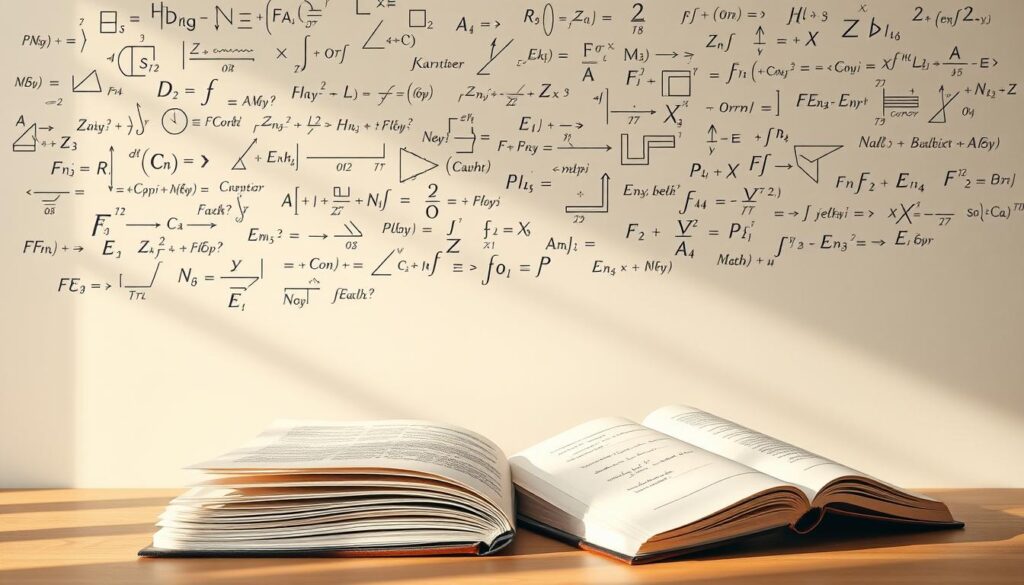Mastering the fundamentals of engineering mathematics is crucial for any aspiring engineer. It lays the groundwork for understanding complex concepts and applying them to real-world problems.
The study of calculus, linear algebra, and differential equations forms the backbone of engineering mathematics. These subjects enable engineers to analyze and solve problems related to motion, forces, and energies.
By grasping these fundamental concepts, engineers can develop innovative solutions to complex challenges. As we explore the world of engineering mathematics, we will delve into the intricacies of these subjects and their practical applications.
Key Takeaways
- Understanding the fundamentals of engineering mathematics is essential for aspiring engineers.
- Calculus, linear algebra, and differential equations are the core subjects in engineering mathematics.
- Mastering these subjects enables engineers to analyze and solve complex problems.
- Practical applications of engineering mathematics are diverse and widespread.
- A strong foundation in engineering mathematics is crucial for innovation and problem-solving.
The Foundation of Modern Engineering
Engineering applications have been revolutionized by the integration of mathematical analysis. This integration has enabled engineers to design, optimize, and predict the behavior of complex systems. As a result, modern engineering has become more precise and efficient.
Why Mathematics Matters in Engineering
Mathematics provides the language and tools necessary for engineers to model real-world problems. Mathematical methods allow for the simulation of various scenarios, reducing the need for physical prototypes and speeding up the development process. By applying mathematical analysis, engineers can optimize system performance and predict potential failures.
For instance, in the field of mechanical engineering, mathematical models are used to simulate the stress and strain on mechanical components. This enables engineers to design safer and more efficient systems. The use of mathematical methods in engineering has become indispensable.
Historical Development of Mathematical Methods in Engineering
The historical development of mathematical methods in engineering dates back to ancient civilizations, where simple mathematical principles were used to construct buildings and bridges. Over time, as mathematics evolved, so did its application in engineering. The development of calculus in the 17th century marked a significant milestone, enabling engineers to model complex phenomena.
“Mathematics is the language with which God has written the universe.” – Galileo Galilei
The table below highlights key milestones in the historical development of mathematical methods in engineering:
| Period | Mathematical Development | Engineering Application |
|---|---|---|
| Ancient Era | Basic geometric principles | Construction of buildings and bridges |
| 17th Century | Development of calculus | Modeling of complex phenomena |
| 20th Century | Advancements in computational mathematics | Simulation and optimization of complex systems |
The integration of mathematical methods in engineering has continued to evolve, with modern engineering relying heavily on computational mathematics and simulation. As engineering applications become increasingly complex, the role of mathematical analysis will only continue to grow.
Understanding Engineering Mathematics
Mathematical thinking is essential for engineers to analyze and solve problems in their field. It involves a combination of mathematical knowledge, problem-solving skills, and the ability to apply these skills to real-world engineering challenges.
Mathematical Thinking for Engineers
Engineers must be able to think mathematically to develop and implement solutions to complex problems. This involves understanding mathematical models and being able to apply them to various engineering scenarios. Mathematical thinking enables engineers to analyze data, identify patterns, and make informed decisions.
The Engineering Approach to Mathematical Problems
The engineering approach to mathematical problems involves a systematic methodology that includes problem formulation and solution strategies. Engineers must be able to formulate problems effectively, identifying key variables and constraints, and then develop appropriate mathematical models to analyze and solve these problems.
Problem Formulation Techniques
Effective problem formulation is critical in engineering mathematics. It involves identifying the key elements of a problem, simplifying complex situations, and developing a mathematical representation that can be analyzed. Techniques such as dimensional analysis and scaling are often used to simplify problems.
Solution Strategies
Once a problem is formulated, engineers must develop a solution strategy. This may involve analytical techniques, numerical methods, or a combination of both. The choice of solution strategy depends on the complexity of the problem and the tools available.
| Problem Type | Formulation Technique | Solution Strategy |
|---|---|---|
| Linear Systems | Matrix Formulation | Numerical Methods |
| Nonlinear Systems | Differential Equations | Iterative Techniques |
| Optimization Problems | Objective Function Definition | Linear/Nonlinear Programming |
By combining mathematical thinking with an engineering approach, professionals can tackle a wide range of challenges. The table above illustrates different problem types, formulation techniques, and solution strategies used in engineering mathematics.

Calculus: The Language of Change and Motion
In the realm of engineering, calculus serves as a powerful language for describing motion and change. It is a fundamental tool that enables engineers to analyze and model complex systems, making it indispensable in various engineering disciplines.
Differential Calculus in Engineering
Differential calculus is concerned with the study of rates of change and slopes of curves. It is crucial for understanding how functions change as their input changes.
Derivatives and Rates of Change
The concept of a derivative is central to differential calculus. It measures how a function changes as its input changes, providing insights into rates of change and slopes of curves. For instance, in mechanics, derivatives are used to determine the velocity and acceleration of objects.
Applications in Mechanics
In mechanics, differential calculus is used to analyze the motion of objects. By calculating derivatives, engineers can determine the velocity and acceleration of moving parts in machines, which is critical for designing safe and efficient mechanical systems.
Integral Calculus Applications
Integral calculus, on the other hand, deals with the accumulation of quantities. It is used to find the area under curves, volumes of solids, and other quantities.
Area and Volume Calculations
One of the primary applications of integral calculus is in calculating areas and volumes. For example, engineers use integral calculus to determine the area under stress-strain curves to understand material properties.
Work and Energy Problems
Integral calculus is also used to solve work and energy problems. By integrating force over distance, engineers can calculate the work done on an object, which is essential for understanding energy transfer in mechanical systems.
| Calculus Type | Application | Engineering Use |
|---|---|---|
| Differential Calculus | Rates of Change | Mechanics, Motion Analysis |
| Integral Calculus | Area and Volume | Material Properties, Structural Analysis |
| Multivariable Calculus | Complex Systems | Thermodynamics, Fluid Dynamics |
Multivariable Calculus for Complex Systems
Multivariable calculus extends the concepts of differential and integral calculus to functions of multiple variables. It is essential for analyzing complex systems that involve multiple factors, such as temperature, pressure, and volume.
As noted by mathematician and physicist Richard Feynman, “Calculus is a language that allows us to understand the world around us.”
By mastering calculus, engineers can better understand and describe the world around them, leading to innovations and improvements in various engineering fields.
Linear Algebra: Matrices and Vector Spaces
In the realm of engineering, linear algebra plays a pivotal role in modeling and analyzing complex systems. It provides a robust framework for understanding and solving problems that involve linear equations and transformations.

Matrix Operations in Engineering
Matrix operations are fundamental in engineering, allowing for the representation and manipulation of complex data. Matrix addition and multiplication are used extensively in solving systems of linear equations, which are crucial in various engineering disciplines.
The use of matrices extends to computer graphics and data analysis, where transformations and statistical operations are performed efficiently using matrix operations.
Eigenvalues and Eigenvectors
Eigenvalues and eigenvectors are critical concepts in linear algebra, providing insights into the properties of linear transformations. Eigenvalues represent how much change occurs in a linear transformation, while eigenvectors indicate the directions of this change.
Applications in Structural Analysis
Linear algebra finds significant applications in structural analysis, where it is used to determine the stability and stress distribution in structures. Stress and strain calculations are critical in understanding how materials behave under different loads.
Stress and Strain Calculations
| Material | Stress (MPa) | Strain (%) |
|---|---|---|
| Steel | 250 | 0.12 |
| Aluminum | 150 | 0.08 |
| Concrete | 30 | 0.02 |
Vibration Analysis
Vibration analysis is another area where linear algebra is applied, particularly in understanding the modal frequencies and mode shapes of structures. This analysis is crucial for designing structures that can withstand various dynamic loads.
Differential Equations in Engineering Practice
Understanding differential equations is essential for engineers as they provide insights into the dynamics of systems and help in making informed decisions. Differential equations are pivotal in modeling various physical phenomena, allowing engineers to predict and analyze the behavior of complex systems.
Ordinary Differential Equations
Ordinary differential equations (ODEs) are used to model systems that change over time or space. They are crucial in understanding the dynamics of mechanical, electrical, and thermal systems.
First-Order Equations
First-order differential equations involve a first derivative and are used in modeling phenomena such as population growth and chemical reactions. They are characterized by their simplicity and are often used in initial value problems.
Second-Order Equations
Second-order differential equations involve a second derivative and are commonly used in modeling oscillatory systems, such as mass-spring systems and electrical circuits. They provide insights into the stability and behavior of these systems.
Partial Differential Equations
Partial differential equations (PDEs) are used to model systems that vary in multiple dimensions, such as heat transfer and fluid dynamics. They are more complex than ODEs and require advanced mathematical techniques for their solution.
Solving Real-World Engineering Problems
Differential equations are instrumental in solving real-world engineering problems. They help in understanding and predicting the behavior of complex systems.
Heat Transfer Applications
In heat transfer, differential equations are used to model conduction, convection, and radiation. They help engineers design more efficient thermal systems.
Fluid Dynamics Models
Fluid dynamics involves the study of fluids in motion. Differential equations, particularly the Navier-Stokes equations, are used to model fluid flow, enabling the design of more efficient systems in aerospace, chemical, and civil engineering.
In conclusion, differential equations are a fundamental tool in engineering practice, enabling the analysis and solution of complex problems across various disciplines.
Probability and Statistics for Engineers
Probability and statistics are essential tools for engineers, enabling them to quantify uncertainty and make data-driven decisions. In engineering, these disciplines are applied to analyze and interpret complex data, ensuring the reliability and quality of systems.

Statistical Analysis Methods
Statistical analysis is a critical component of engineering, allowing professionals to extract insights from data. Common methods include hypothesis testing, regression analysis, and confidence intervals. These techniques help engineers understand the behavior of complex systems and make informed decisions.
Hypothesis testing is used to validate assumptions about a system or process. Regression analysis helps in understanding the relationship between variables, while confidence intervals provide a range of values within which a population parameter is likely to lie.
Reliability Engineering
Reliability engineering focuses on ensuring that systems perform their intended functions under specified conditions for a given period. This involves analyzing failure rates, mean time between failures (MTBF), and mean time to repair (MTTR). By understanding these metrics, engineers can design more reliable systems.
Quality Control Applications
Quality control is vital in engineering to ensure that products or services meet specified requirements. Statistical process control (SPC) and Six Sigma are two methodologies used to achieve high-quality standards.
Six Sigma Methodology
Six Sigma is a data-driven approach to quality management that aims to reduce defects and variations in processes. It uses a belt-based certification system and emphasizes continuous improvement.
Statistical Process Control
Statistical process control involves monitoring and controlling processes through statistical methods. It helps in detecting deviations from the norm, allowing for corrective actions to be taken promptly.
| Methodology | Description | Application |
|---|---|---|
| Six Sigma | Data-driven quality management | Reducing defects and variations |
| Statistical Process Control | Monitoring and controlling processes | Detecting deviations and corrective actions |
By applying these methodologies, engineers can significantly improve the quality and reliability of their projects, ultimately leading to better outcomes and customer satisfaction.
Numerical Methods and Computational Mathematics
In the realm of engineering, numerical methods and computational mathematics are indispensable tools for problem-solving. These methodologies enable engineers to analyze complex systems, predict behavior, and optimize designs.
Approximation Techniques
Approximation techniques are fundamental in numerical methods, allowing for the simplification of complex mathematical problems. Techniques such as interpolation and extrapolation are widely used to estimate values between or beyond known data points.
Error Analysis
Error analysis is crucial in numerical methods to understand the accuracy of the results. Engineers must be able to quantify and minimize errors to ensure reliable solutions. This involves understanding the sources of errors, such as round-off errors and truncation errors.
Computer-Aided Solutions
Computer-aided solutions have revolutionized the field of engineering by enabling the efficient computation of complex problems. Software tools based on numerical methods are used extensively for simulation, analysis, and design.
Finite Element Analysis
Finite Element Analysis (FEA) is a powerful computational method used to simulate physical phenomena under various types of loads. It’s widely used in structural, thermal, and fluid dynamics analyses.
Computational Fluid Dynamics
Computational Fluid Dynamics (CFD) is another critical tool that uses numerical methods to analyze fluid flow, heat transfer, and other related phenomena. CFD is essential in designing and optimizing systems involving fluid flow.
By leveraging numerical methods and computational mathematics, engineers can tackle complex problems with greater accuracy and efficiency, driving innovation and improvement in various engineering disciplines.
Mathematical Modeling in Engineering
The application of mathematical modeling in engineering has revolutionized the way professionals approach problem-solving and system design. By creating mathematical representations of real-world systems, engineers can analyze, predict, and optimize performance.
Creating Mathematical Models
Developing a mathematical model involves translating physical phenomena into mathematical expressions. This process requires a deep understanding of both the underlying mathematics and the physical system being modeled. Key steps include:
- Defining the problem and identifying the key variables
- Formulating equations that describe the system’s behavior
- Simplifying assumptions to make the model tractable
Simulation and Validation
Once a model is developed, simulation allows engineers to test the model under various conditions. Validation is crucial to ensure that the model’s predictions align with real-world observations. This involves comparing simulation results with experimental data.

Case Studies in Various Engineering Fields
Mathematical modeling is applied across diverse engineering disciplines. Here, we explore its application in mechanical systems and electrical circuit modeling.
Mechanical Systems Modeling
In mechanical engineering, mathematical models are used to design and analyze systems such as mechanical vibrations and thermodynamic systems. For instance, modeling the vibration of a bridge under different loads helps in assessing its structural integrity.
Electrical Circuit Modeling
For electrical engineers, mathematical models are indispensable for designing and analyzing electrical circuits. These models help predict circuit behavior under various conditions, facilitating the design of more efficient and reliable systems.
Through case studies like these, the versatility and power of mathematical modeling in engineering become evident. By leveraging these models, engineers can innovate and improve systems across different fields.
Optimization Techniques for Engineering Problems
The application of optimization techniques in engineering has revolutionized problem-solving approaches. Engineers now have a robust toolkit to tackle complex problems, improve designs, and enhance manufacturing processes.
Linear and Nonlinear Optimization
Optimization techniques can be broadly categorized into linear and nonlinear optimization. Linear optimization involves problems where the objective function and constraints are linear. This technique is widely used in resource allocation and production planning. On the other hand, nonlinear optimization deals with problems where the objective function or constraints are nonlinear, often requiring more sophisticated algorithms to solve.
Constrained Optimization
Many engineering problems involve constraints, such as material limitations or regulatory requirements. Constrained optimization techniques are designed to handle these limitations, ensuring that the optimal solution is feasible in the real world. Techniques like Lagrange multipliers are commonly used in this context.
Applications in Design and Manufacturing
Optimization techniques have numerous applications in design and manufacturing. By optimizing design parameters, engineers can achieve better performance and reduce material usage. In manufacturing, process optimization can lead to significant cost savings and improved product quality.
Material Selection Optimization
One critical aspect of design optimization is material selection. By choosing the right materials, engineers can optimize properties such as strength, weight, and cost. Material selection optimization involves analyzing various materials and selecting the one that best meets the design requirements.
Process Optimization
In manufacturing, process optimization is crucial for efficiency and cost-effectiveness. This involves optimizing process parameters such as temperature, pressure, and flow rates to achieve the desired output. Techniques like response surface methodology are often used to optimize these processes.
| Optimization Technique | Application | Benefits |
|---|---|---|
| Linear Optimization | Resource allocation, production planning | Efficient use of resources, cost savings |
| Nonlinear Optimization | Complex system design, nonlinear problems | Improved performance, handling complex constraints |
| Constrained Optimization | Design and manufacturing with constraints | Feasible solutions, regulatory compliance |
Complex Analysis in Engineering Applications
The application of complex analysis in engineering has revolutionized the field, providing insights into electrical engineering and signal processing. Complex analysis, which involves the study of complex variables and functions, has become a fundamental tool for engineers.
Complex Variables and Functions
Complex variables are crucial in understanding many engineering phenomena. Complex functions, in particular, are used to model various physical systems, enabling engineers to analyze and predict their behavior under different conditions.
Applications in Electrical Engineering
In electrical engineering, complex analysis is used to design and analyze circuits. Complex impedance is a key concept here, helping engineers understand how circuits respond to different frequencies. This is particularly important in filter design and signal processing.
Signal Processing Fundamentals
Signal processing is another area where complex analysis plays a vital role. Two fundamental techniques used in signal processing are Fourier analysis and Laplace transforms.
Fourier Analysis
Fourier analysis allows engineers to decompose signals into their constituent frequencies. This is crucial in understanding signal characteristics and filtering out unwanted frequencies.
Laplace Transforms
Laplace transforms are used to analyze systems and signals in the s-domain, providing insights into system stability and response. They are particularly useful in control systems engineering.

| Technique | Application | Benefit |
|---|---|---|
| Fourier Analysis | Signal Decomposition | Understanding signal characteristics |
| Laplace Transforms | System Analysis | Insights into system stability and response |
By applying complex analysis, engineers can simplify complex problems, making it easier to design, analyze, and optimize systems. This has significant implications for advancements in electrical engineering, signal processing, and beyond.
Practical Applications of Engineering Mathematics
Practical applications of engineering mathematics are diverse and widespread across different engineering disciplines. Mathematics plays a crucial role in solving real-world problems, and its application varies significantly depending on the engineering field.
Civil and Structural Engineering
In civil and structural engineering, mathematical models are used to design and analyze structures such as bridges, buildings, and dams. Mathematical techniques like differential equations and linear algebra help engineers predict the behavior of these structures under various conditions.
| Engineering Field | Mathematical Application |
|---|---|
| Civil Engineering | Structural analysis, stress calculation |
| Structural Engineering | Dynamic analysis, material strength |
Electrical and Computer Engineering
Electrical and computer engineering rely heavily on mathematical principles for circuit analysis, signal processing, and control systems. Complex analysis is particularly important in electrical engineering for understanding AC circuits and signal processing.
Mechanical and Aerospace Engineering
Mechanical and aerospace engineering use mathematical models to analyze and optimize systems. For instance, thermodynamics and fluid dynamics are crucial in designing more efficient engines and aircraft.
Chemical and Biomedical Engineering
Chemical and biomedical engineering apply mathematical techniques to model chemical reactions, process dynamics, and biological systems. Numerical methods are used to solve complex equations that describe these systems.
In conclusion, the practical applications of engineering mathematics are vast and varied, impacting numerous engineering disciplines. By applying mathematical principles, engineers can develop innovative solutions to complex problems.
Essential Tools and Resources for Engineering Mathematics
Mastering engineering mathematics requires a robust set of essential tools and resources. Engineers and mathematicians rely on these to solve complex problems, model real-world systems, and analyze data.
Software and Computational Tools
Software plays a crucial role in engineering mathematics. Two of the most widely used tools are:
MATLAB and Simulink
MATLAB is a high-level programming language and environment that is particularly useful for numerical computation and data analysis. Simulink is a graphical modeling and simulation environment that is often used in conjunction with MATLAB.
Python for Engineering Calculations
Python is another popular language used in engineering mathematics, known for its simplicity and the extensive libraries available, such as NumPy and SciPy.

Recommended Textbooks and Online Resources
For those looking to deepen their understanding of engineering mathematics, there are numerous textbooks and online resources available. Textbooks provide comprehensive coverage of topics, while online resources offer flexibility and accessibility.
| Resource Type | Examples |
|---|---|
| Textbooks | Advanced Engineering Mathematics by Erwin Kreyszig |
| Online Resources | Khan Academy, MIT OpenCourseWare |
Professional Development Opportunities
Finally, professional development is key to staying current in the field of engineering mathematics. This can include attending conferences, participating in workshops, and pursuing further education.
Conclusion
Engineering mathematics is the backbone of modern engineering, providing the fundamental tools and techniques necessary to analyze and solve complex problems. Throughout this article, we have explored the various aspects of engineering mathematics, from calculus and linear algebra to differential equations and numerical methods.
The importance of engineering mathematics lies in its ability to provide a common language and framework for engineers to describe and analyze real-world problems. By mastering these mathematical concepts, engineers can develop innovative solutions, optimize systems, and predict behavior.
In conclusion, engineering mathematics is a vital component of modern engineering, and its applications continue to grow and expand into new areas. As engineers, it is essential to have a strong foundation in these mathematical principles to tackle the complex challenges of the 21st century.
